Assessing Nonstationary Spatial Patterns of Extreme Droughts from Long-Term High-Resolution Observational Dataset on a Semiarid Basin (Spain)
Abstract
:1. Introduction
2. Characterization of Study Basin and Dataset
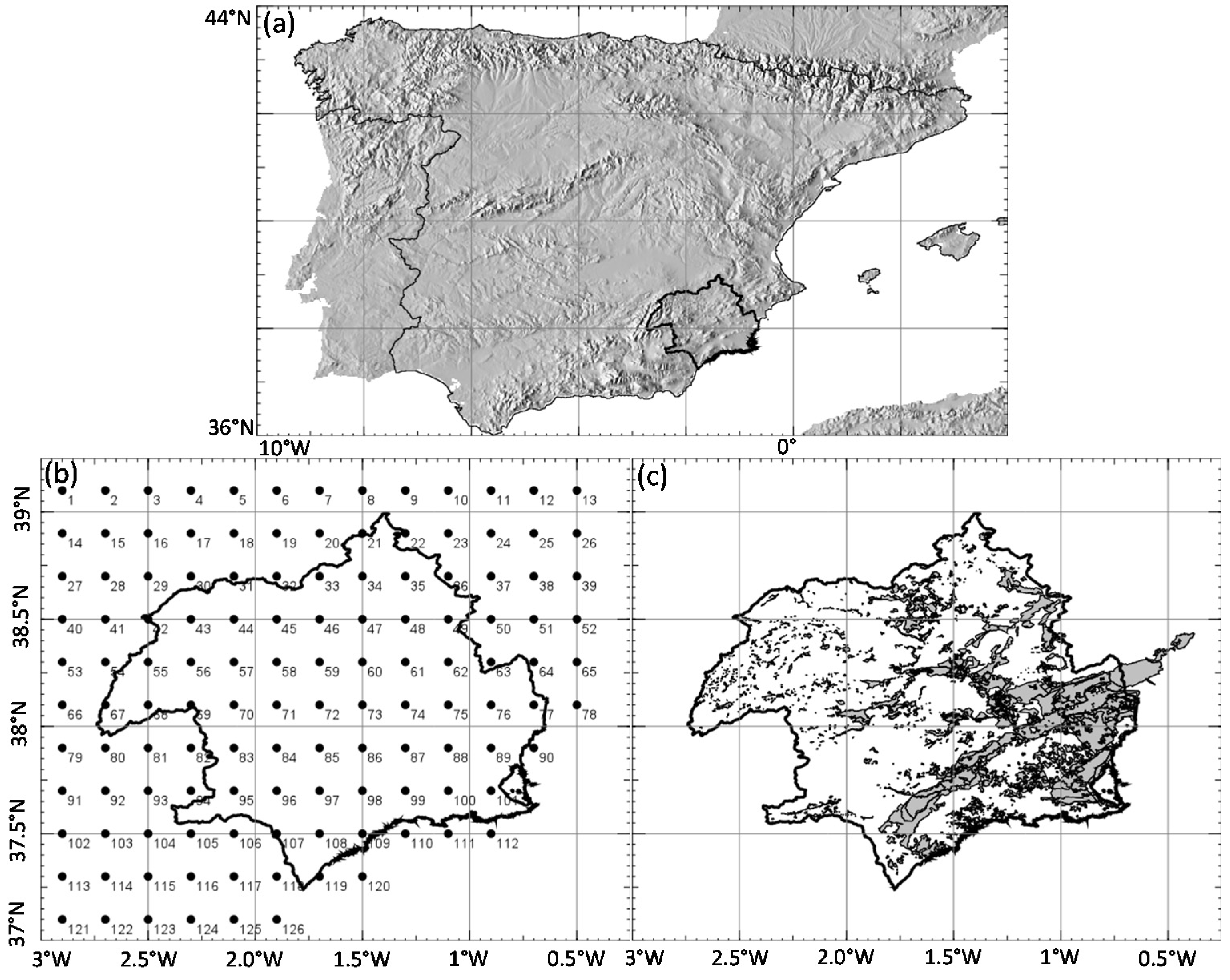
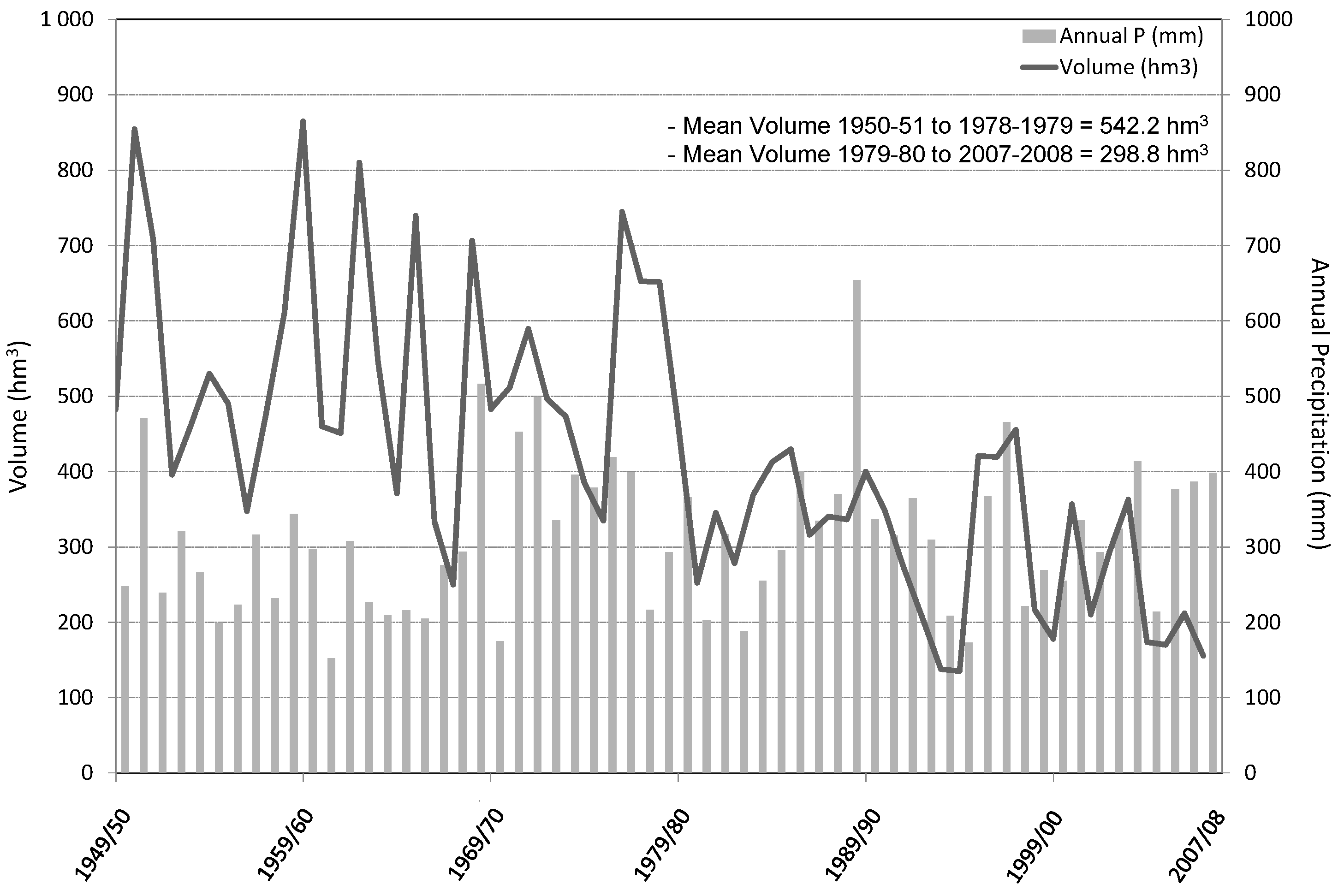
3. Analysis of Spatial Distributions of Length and Number of Dry Spells
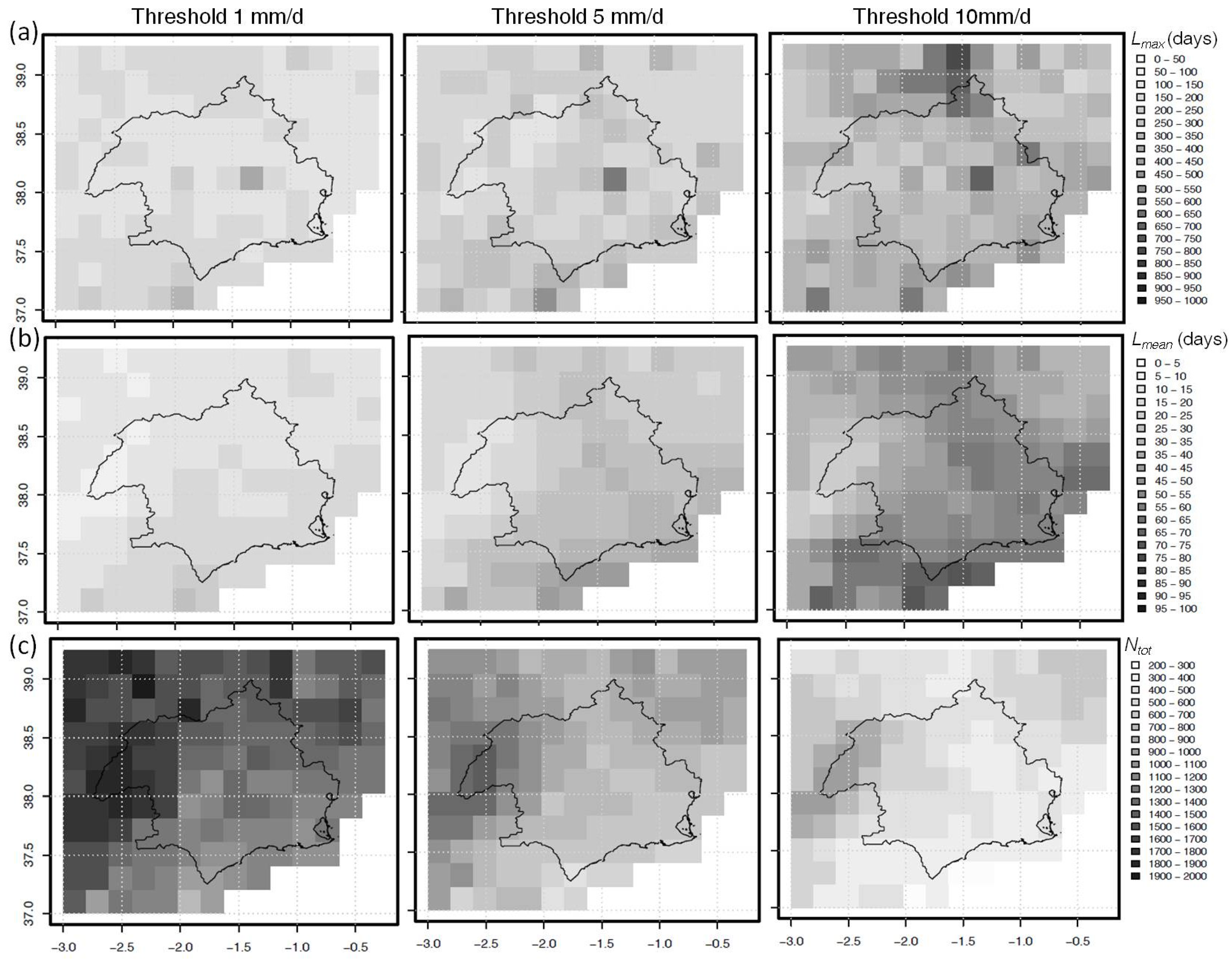
4. Analysis of Time Series: Application of GAMLSS Tools
Analysis of Trends of Annual Maximum Dry Spells Lengths (MDSL)
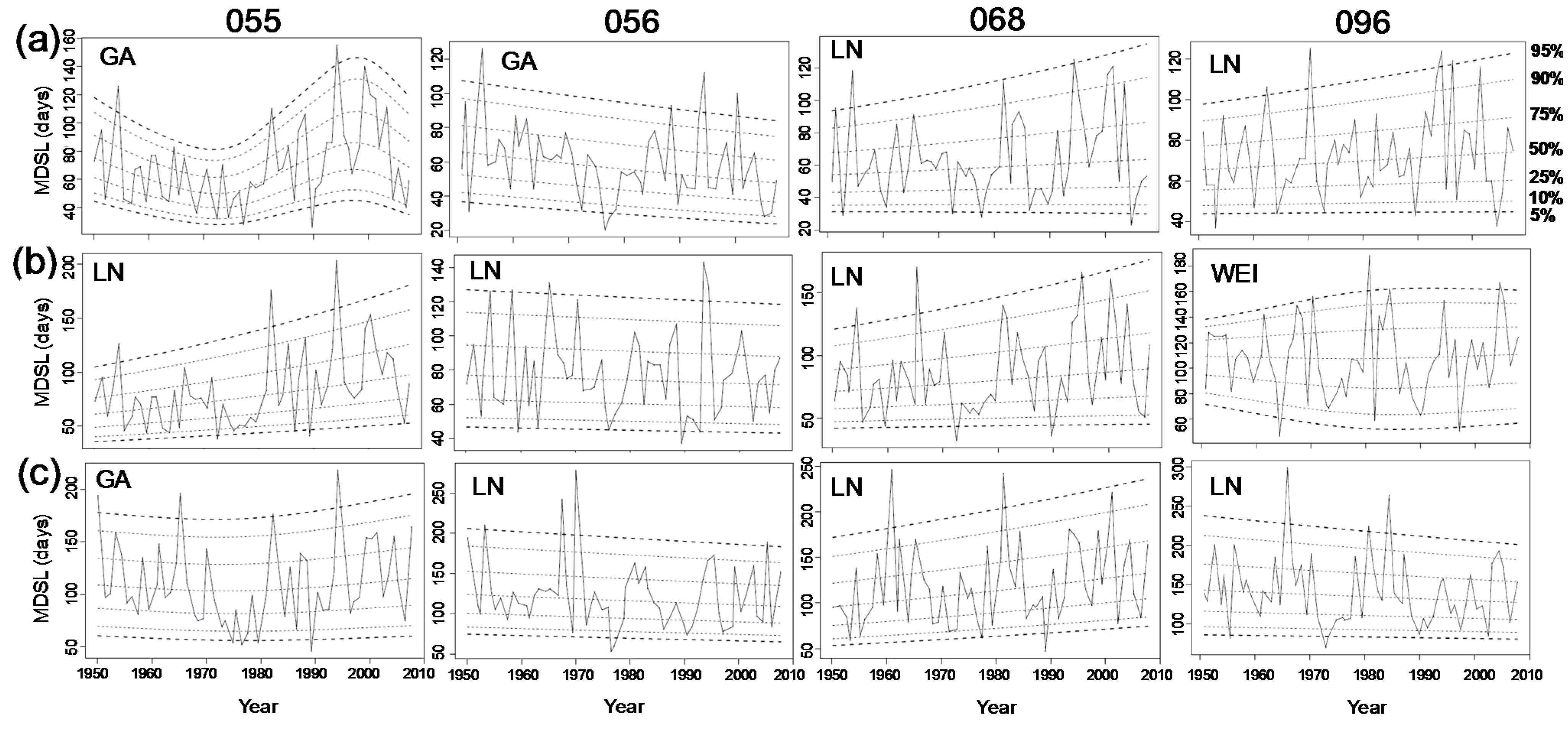
5. Generation of Non-Stationary Spatial Distributions of MDSL
5.1. Spatial Distributions of Mean and Standard Deviations

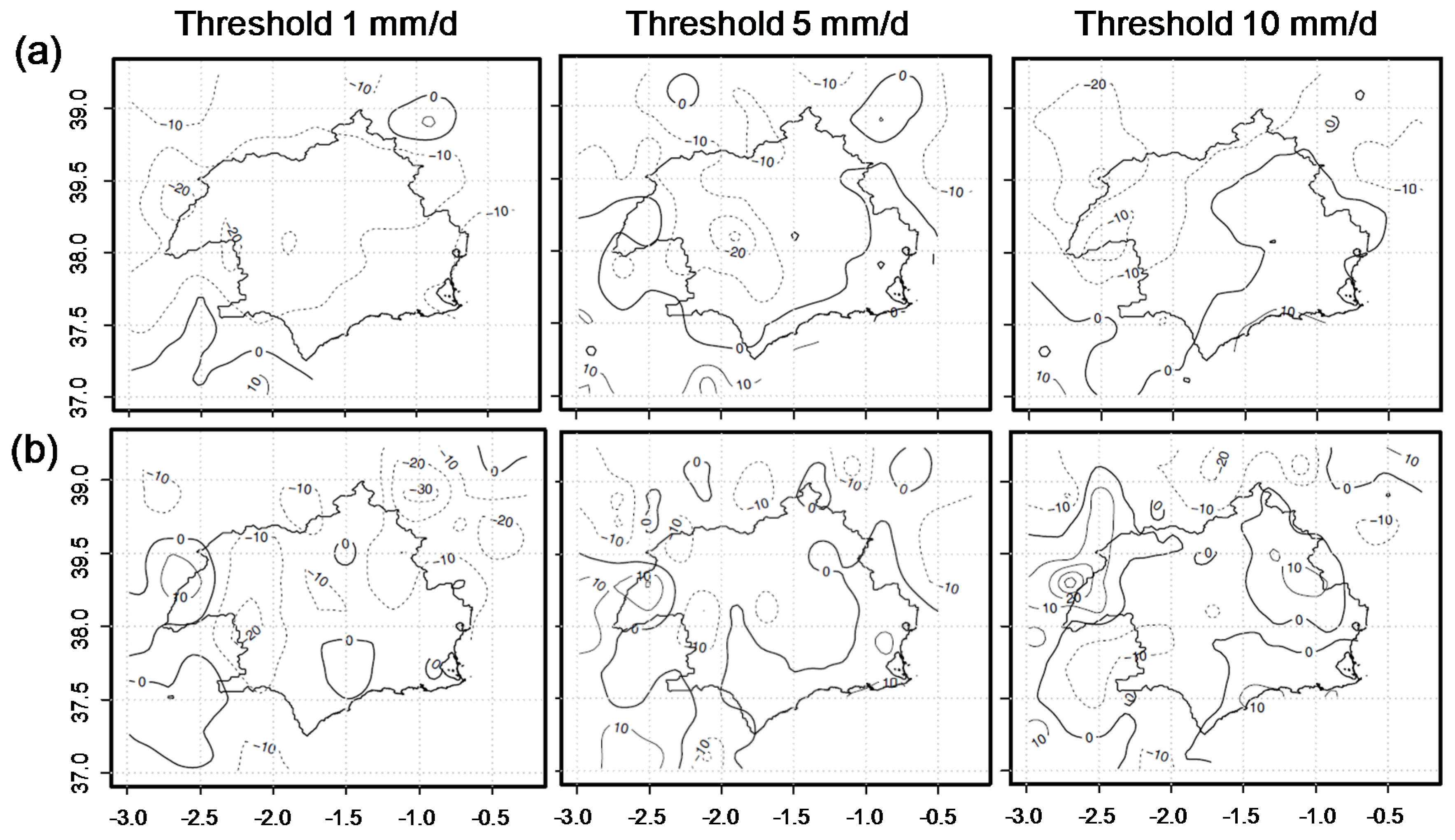
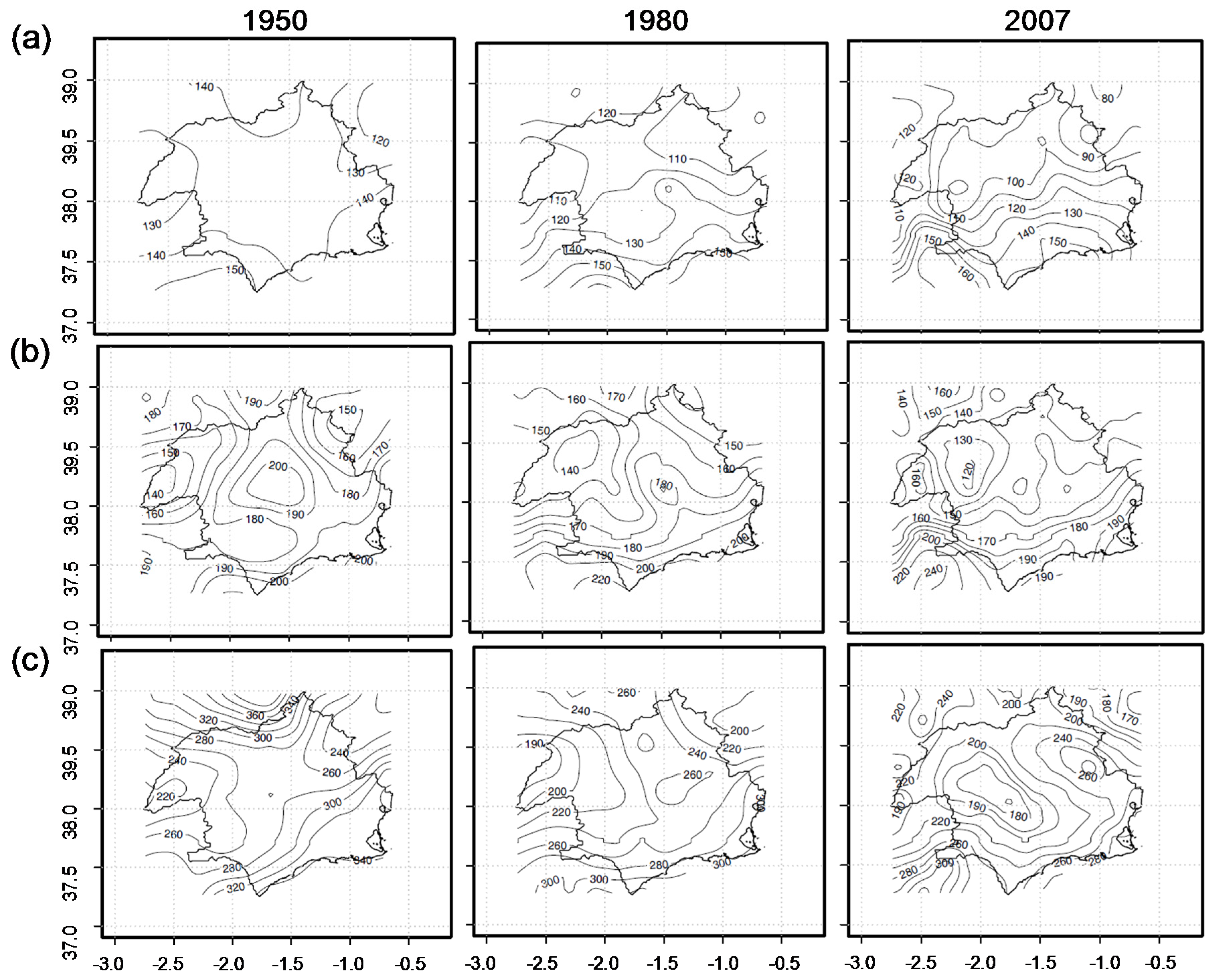
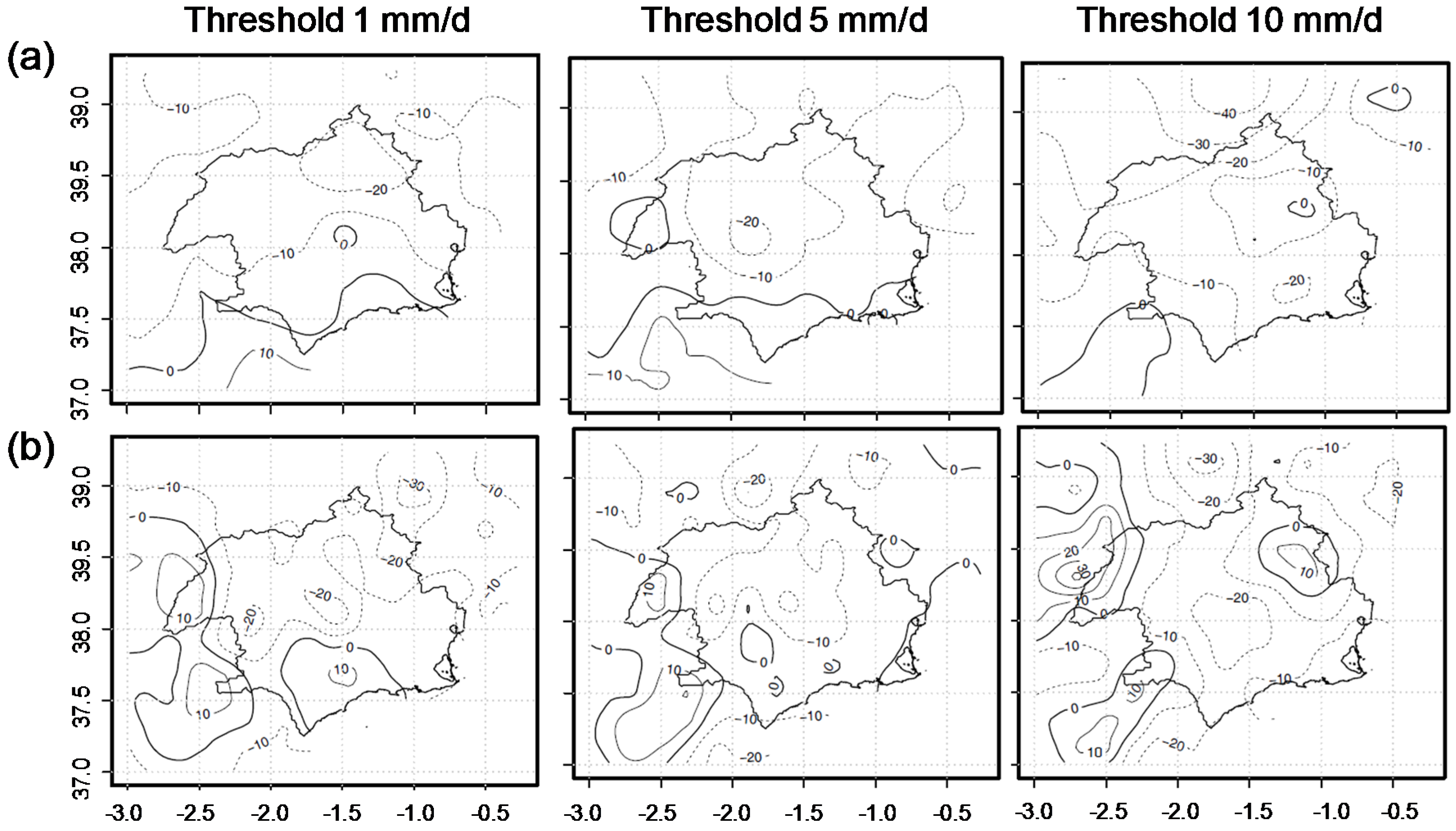
5.2. Spatial Distributions of MDLS Associated to Return Periods (Tr)

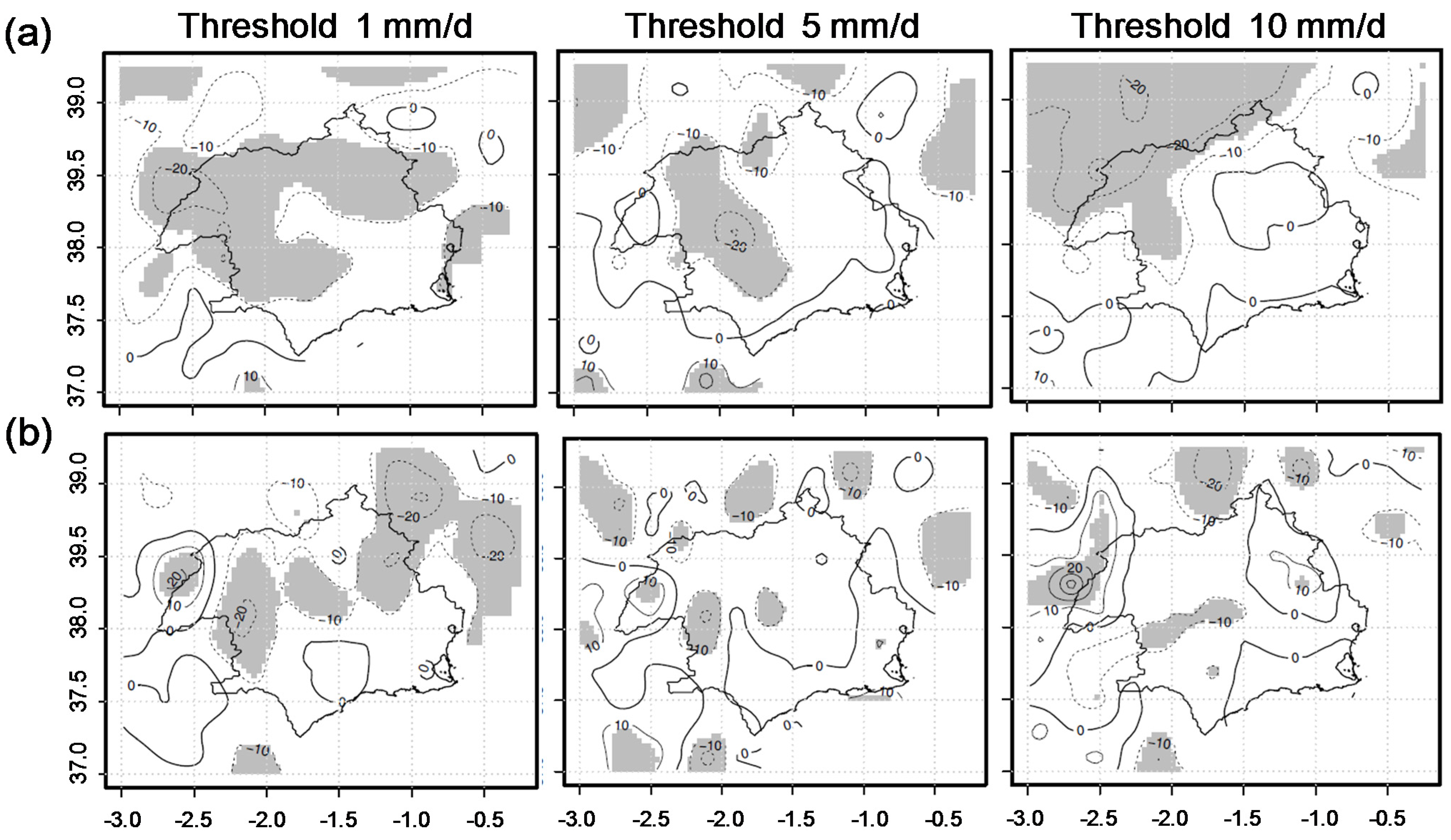
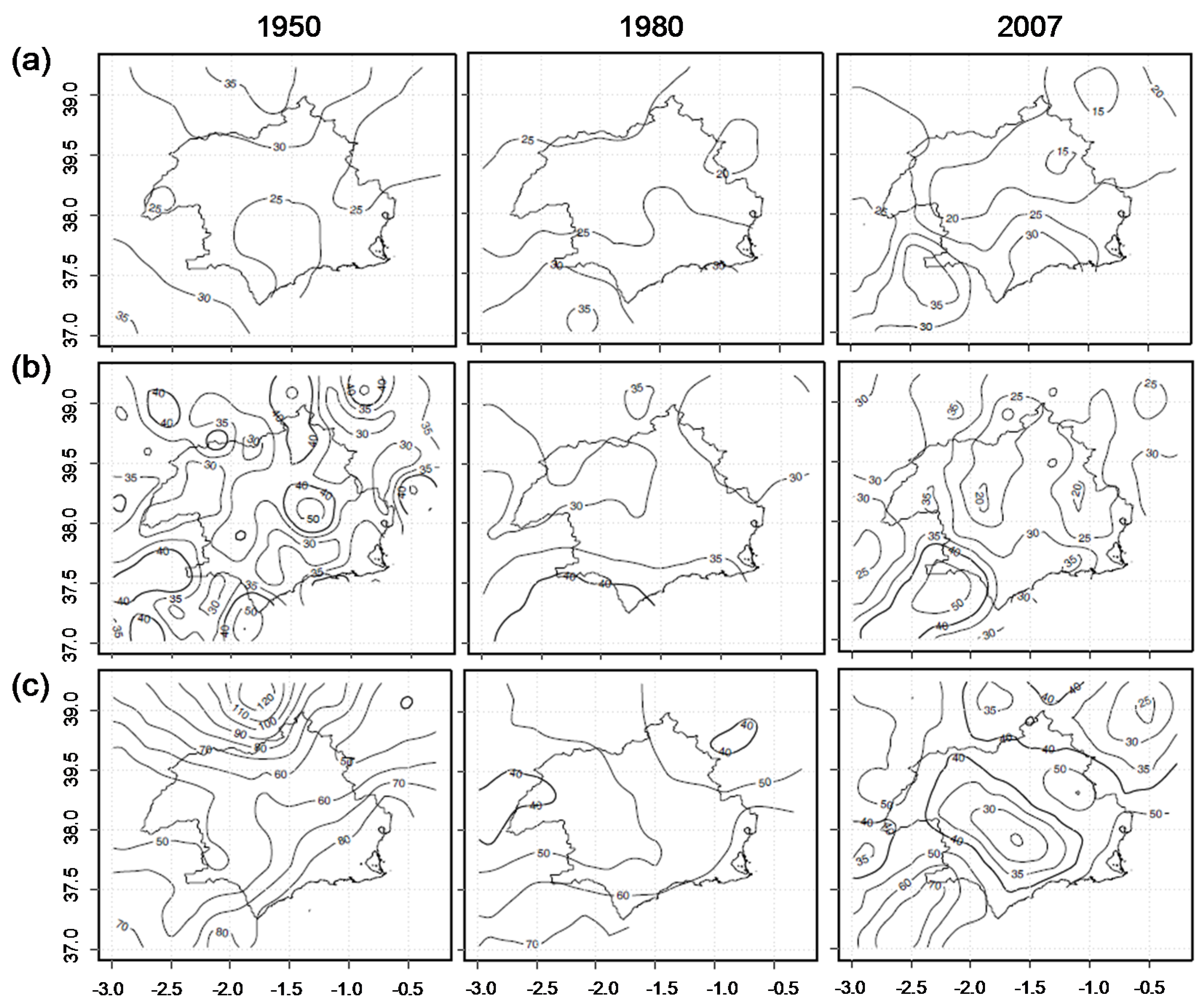

6. Discussion and Conclusions
Acknowledgments
Author Contributions
Conflicts of Interest
References
- Labat, D.; Goddéris, Y.; Probst, J.L.; Guyot, J.L. Evidence for global runoff increase related to climate warming. Adv. Water Resour. 2004, 27, 631–642. [Google Scholar] [CrossRef] [Green Version]
- Huntington, T.G. Evidence for intensification of the global water cycle: Review and synthesis. J. Hydrol. 2006, 319, 83–95. [Google Scholar] [CrossRef]
- Kundzewicz, Z.W.; Mata, L.J.; Arnell, N.; Döll, P.; Kabat, P.; Jiménez, B.; Miller, K.; Oki, T.; Sen, Z.; Shiklomanov, I. Freshwater resources and their management. In Climate Change 2007: Impacts, Adaptation and Vulnerability. Contribution of Working Group II to the Fourth Assessment Report of the Intergovernmental Panel on Climate Change; Parry, M.L., Canziani, O.F., Palutikof, J.P., van der Linden, P.J., Hanson, C.E., Eds.; Cambridge University Press: Cambridge, UK, 2007; pp. 173–210. [Google Scholar]
- Milly, P.C.D.; Betancourt, J.; Falkenmark, M.; Hirsch, R.M.; Kundzewicz, Z.W.; Lettenmaier, D.P.; Stouffer, R.J. Stationarity is dead: Whither water management? Science 2008, 319, 573–574. [Google Scholar] [CrossRef] [PubMed]
- Hirsch, R.M. A perspective on nonstationarity and water management1. J. Am. Water Resour. Assoc. 2011, 47, 436–446. [Google Scholar] [CrossRef]
- Rigby, B.; Stasinopoulos, M.; Akantziliotou, C. Generalized additive models for location, scale and shape. Appl. Stat. 2005, 54, 507–554. [Google Scholar] [CrossRef]
- Mishra, A.K.; Singh, V.P. Drought modeling—A review. J. Hydrol. 2011, 403, 157–175. [Google Scholar] [CrossRef]
- Dracup, J.A.; Lee, K.S.; Paulson, E.G. On the definition of droughts. Water Resour. Res. 1980, 16, 297–302. [Google Scholar] [CrossRef]
- Martin-Vide, J.; Gomez, L. Regionalization of peninsular Spain based on the length of dry spells. Int. J. Climatol. 1999, 19, 537–555. [Google Scholar] [CrossRef]
- Paredes, D.; Trigo, R.M.; Garcia-Herrera, R.; Trigo, I.F. Understanding precipitation changes in Iberia in early spring: Weather typing and storm-tracking approaches. J. Hydrometeorol. 2006, 7, 101–113. [Google Scholar] [CrossRef]
- Vicente-Serrano, S.M.; Cuadrat-Prats, J.M. Trends in drought intensity and variability in the middle Ebro valley (NE of the Iberian Peninsula) during the second half of the twentieth century. Theor. Appl. Climatol. 2006, 88, 247–258. [Google Scholar] [CrossRef]
- Wet and Dry Spell Analysis Using Copulas. Available online: http://onlinelibrary.wiley.com/doi/10.1002/joc.4369/abstract;jsessionid=7114E4C372F3FEE469EDBF7D9646077C.f01t02?userIsAuthenticated=false&deniedAccessCustomisedMessage= (accessed on 5 October 2015).
- García-Herrera, R.; Hernández, E.; Barriopedro, D.; Paredes, D.; Trigo, R.M.; Trigo, I.F.; Mendes, M.A. The outstanding 2004/05 drought in the Iberian Peninsula: Associated atmospheric circulation. J. Hydrometeorol. 2007, 8, 483–498. [Google Scholar] [CrossRef]
- Estrela, M.J.; Peñarrocha, D.; Millán, M. Multi-annual drought episodes in the Mediterranean (Valencia region) from 1950–1996. A spatio-temporal analysis. Int. J. Climatol. 2000, 20, 1599–1618. [Google Scholar] [CrossRef]
- Vicente-Serrano, S.M.; López-Moreno, J.I. Hydrological response to different time scales of climatological drought: An evaluation of the standardized precipitation index in a mountainous Mediterranean basin. Hydrol. Earth Syst. Sci. 2005, 9, 523–533. [Google Scholar]
- López-Moreno, J.I.; Beguería, S.; Vicente-Serrano, S.M.; García-Ruiz, J.M. Influence of the North Atlantic Oscillation on water resources in central Iberia: Precipitation, streamflow anomalies, and reservoir management strategies. Water Resour. Res. 2007, 43, W09411. [Google Scholar] [CrossRef]
- Lorenzo-Lacruz, J.; Vicente-Serrano, S.M.; López-Moreno, J.I.; Beguería, S.; García-Ruiz, J.M.; Cuadrat, J.M. The impact of droughts and water management on various hydrological systems in the headwaters of the Tagus River (central Spain). J. Hydrol. 2010, 386, 13–26. [Google Scholar] [CrossRef] [Green Version]
- Boix-Fayos, C.; Barberá, G.G.; López-Bermúdez, F.; Castillo, V.M. Effects of check dams, reforestation and land-use changes on river channel morphology: Case study of the Rogativa catchment (Murcia, Spain). Geomorphology 2007, 91, 103–123. [Google Scholar] [CrossRef]
- González del Tánago, M.; Bejarano, M.D.; García de Jalón, D.; Schmidt, J.C. Biogeomorphic responses to flow regulation and fine sediment supply in Mediterranean streams (the Guadalete River, southern Spain). J. Hydrol. 2015, 528, 751–762. [Google Scholar] [CrossRef]
- Rodríguez-Caballero, E.; Cantón, Y.; Lazaro, R.; Solé-Benet, A. Cross-scale interactions between surface components and rainfall properties. Non-linearities in the hydrological and erosive behavior of semiarid catchments. J. Hydrol. 2014, 517, 815–825. [Google Scholar] [CrossRef]
- Ibrahim, B.; Karambiri, H.; Polcher, J. Hydrological impacts of the changes in simulated rainfall fields on Nakanbe Basin in Burkina Faso. Climate 2015, 3, 442–458. [Google Scholar] [CrossRef]
- Herrera, S.; Gutiérrez, J.M.; Ancell, R.; Pons, M.R.; Frías, M.D.; Fernández, J. Development and analysis of a 50-year high-resolution daily gridded precipitation dataset over Spain (Spain02). Int. J. Climatol. 2012, 32, 74–85. [Google Scholar] [CrossRef] [Green Version]
- Urrea Mallebrera, M.A.; Mérida Abril, A.; García Galiano, S.G. Segura River Basin: Spanish pilot river basin regarding water scarcity and droughts. In Agricultural Drought Indices. Proceedings of the WMO/UNISDR Expert Group Meeting on Agricultural Drought Indices; Mannava, V.K.S., Motha, R.P., Wilhite, D.A., Wood, D.A., Eds.; World Meteorological Organization: Geneva, Switzerland, 2011. [Google Scholar]
- Brouwer, C.; Heibloem, M. Irrigation Water Management, Training Manual 3: Irrigation Water Needs. Available online: http://www.fao.org/docrep/s2022e/s2022e00.HTM (accessed on 15 September 2015).
- Karl, T.R.; Nicholls, N.; Ghazi, A. Clivar/GCOS/WMO workshop on indices and indicators for climate extremes workshop summary. Clim. Chang. 1999, 42, 3–7. [Google Scholar] [CrossRef]
- Stasinopoulos, M.; Rigby, R.A. Generalized additive models for location scale and shape (GAMLSS) in R. J. Stat. Softw. 2007, 23, 1–46. [Google Scholar] [CrossRef]
- Villarini, G.; Smith, J.A.; Serinaldi, F.; Bales, J.; Bates, P.D.; Krajewski, W.F. Flood frequency analysis for nonstationary annual peak records in an urban drainage basin. Adv. Water Resour. 2009, 32, 1255–1266. [Google Scholar] [CrossRef]
- Giraldo Osorio, J.D.; García Galiano, S.G. Building hazard maps of extreme daily rainy events from PDF ensemble, via REA method, on Senegal River Basin. Hydrol. Earth Syst. Sci. 2011, 15, 3605–3615. [Google Scholar] [CrossRef]
- Schwarz, G. Estimating the dimension of a model. Ann. Stat. 1978, 6, 461–464. [Google Scholar] [CrossRef]
- Akaike, H. A new look at the statistical model identification. IEEE Trans. Autom. Control 1974, 19, 716–723. [Google Scholar] [CrossRef]
- Filliben, J.J. The probability plot correlation coefficient test for normality. Technometrics 1975, 17, 111–117. [Google Scholar] [CrossRef]
- Van Buuren, S.; Fredriks, M. Worm plot: A simple diagnostic device for modelling growth reference curves. Stat. Med. 2001, 20, 1259–1277. [Google Scholar] [CrossRef] [PubMed]
- López Bustos, C. Contribución al estudio del régimen de precipitaciones de Ciudad Real y su provincia. In Cuadernos de Estudios Manchegos; Publicaciones del Instituto de Estudios Manchegos: Ciudad Real, Spain, 1958; pp. 55–71. (In Spanish) [Google Scholar]
- Katz, R.W.; Brown, B.G. Extreme events in a changing climate: Variability is more important than averages. Clim. Chang. 1992, 21, 289–302. [Google Scholar] [CrossRef]
- Villarini, G.; Smith, J.A. Analysis of the stationarity of floods peaks in the United States. In Workshop of Nonstationarity, Hydrologic Frequency Analysis, and Water Management; Olsen, J.R., Kiang, J., Waskom, R., Eds.; Colorado Water Institute: Boulder, CO, USA, 2010; pp. 81–97. [Google Scholar]
© 2015 by the authors; licensee MDPI, Basel, Switzerland. This article is an open access article distributed under the terms and conditions of the Creative Commons Attribution license (http://creativecommons.org/licenses/by/4.0/).
Share and Cite
Garcia Galiano, S.G.; Olmos Gimenez, P.; Giraldo-Osorio, J.D. Assessing Nonstationary Spatial Patterns of Extreme Droughts from Long-Term High-Resolution Observational Dataset on a Semiarid Basin (Spain). Water 2015, 7, 5458-5473. https://doi.org/10.3390/w7105458
Garcia Galiano SG, Olmos Gimenez P, Giraldo-Osorio JD. Assessing Nonstationary Spatial Patterns of Extreme Droughts from Long-Term High-Resolution Observational Dataset on a Semiarid Basin (Spain). Water. 2015; 7(10):5458-5473. https://doi.org/10.3390/w7105458
Chicago/Turabian StyleGarcia Galiano, Sandra G., Patricia Olmos Gimenez, and Juan Diego Giraldo-Osorio. 2015. "Assessing Nonstationary Spatial Patterns of Extreme Droughts from Long-Term High-Resolution Observational Dataset on a Semiarid Basin (Spain)" Water 7, no. 10: 5458-5473. https://doi.org/10.3390/w7105458






